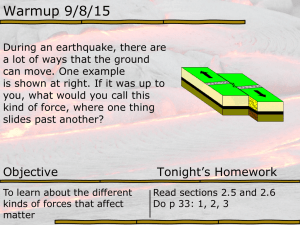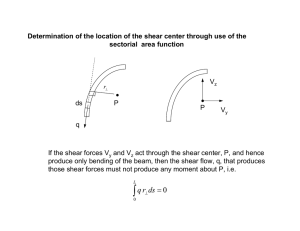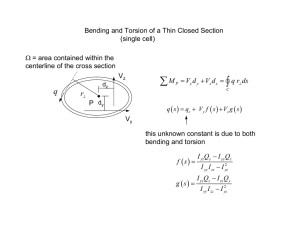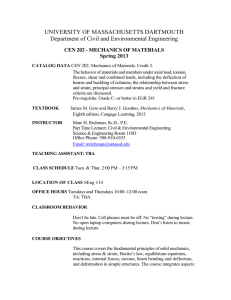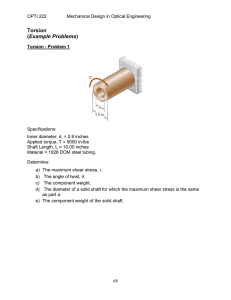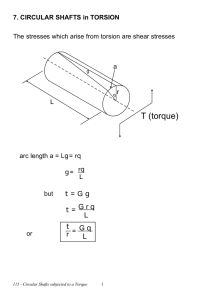26 The results we obtained for the torsion of a thin... some qualifications, for other thin open sections such as shown...
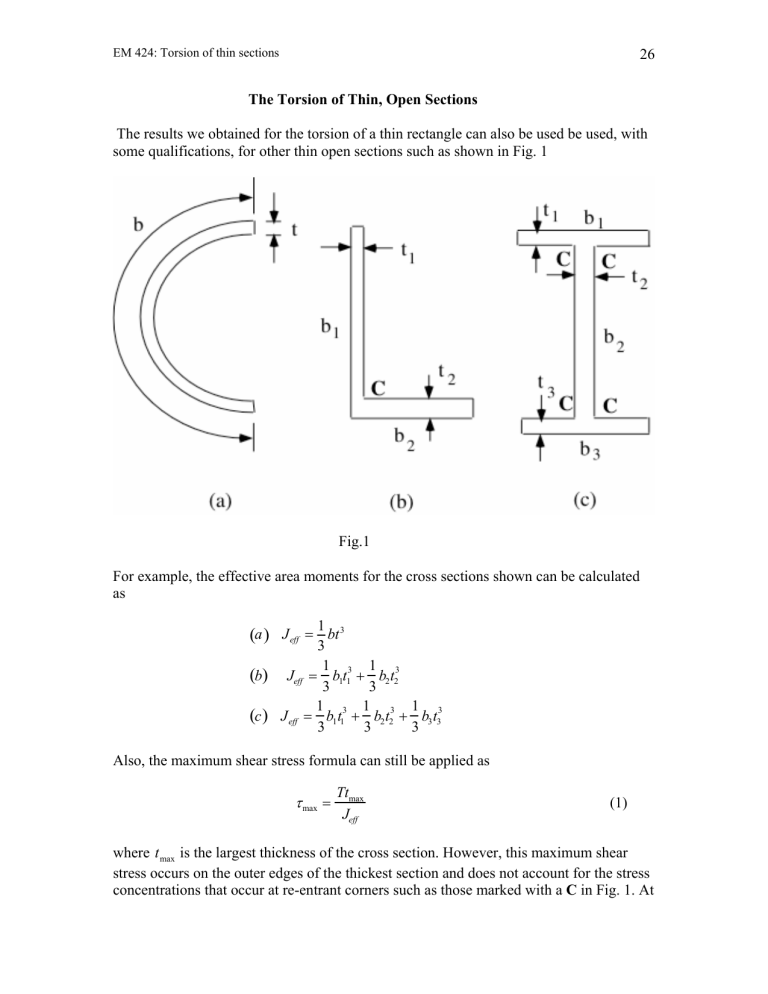
EM 424: Torsion of thin sections 26
The Torsion of Thin, Open Sections
The results we obtained for the torsion of a thin rectangle can also be used be used, with some qualifications, for other thin open sections such as shown in Fig. 1
Fig.1
For example, the effective area moments for the cross sections shown can be calculated as
( )
J eff
=
1
3 bt 3
( )
J eff
=
1
3 b
1 t
1
3 +
1
3 b
2 t
2
3
( )
J eff
=
1
3 b
1 t
1
3 +
1
3 b
2 t
2
3 +
1
3 b
3 t
3
3
Also, the maximum shear stress formula can still be applied as
τ max
=
Tt max
J eff
(1) where t max
is the largest thickness of the cross section. However, this maximum shear stress occurs on the outer edges of the thickest section and does not account for the stress concentrations that occur at re-entrant corners such as those marked with a C in Fig. 1. At
EM 424: Torsion of thin sections 27 such locations, the stresses depend on the local radius of curvature of the corner and may be considerably larger than the value predicted from Eq. (1). Such stress concentrations can be taken into account by finding either numerically or experimentally a stress concentration factor, K , for each re-entrant corner and then examining all high stress points and choosing the one with the highest stress, i.e.
τ max
⎡
=
K
J
Tt eff
⎤
⎦ max
(2)
Another difference between the behavior of general thin open section and the thin rectangular section we considered previously is that a general open section can experience a significant warping displacement, u x
, along the centerline of the cross section, whereas the warping along the centerline of the thin rectangle is zero. You can experience this tendency of thin open sections to warp by simply twisting a thin rolled up piece of paper and see what happens. To obtain an expression for this centerline warping, consider the displacement along this line in the cross section, u s
, as shown in Fig. 2 s z
α u s
,
σ xs e n r r e z
O y e y
Fig.2
Breaking this displacement into its components along the y - and z -axes and using the
Saint Venant assumptions for the y- and z- displacements, we have
EM 424: Torsion of thin sections 28 u s
= − u y sin
α + u z cos
α
= z
φ ( ) sin
α + y
φ x cos
α
= r
⊥
φ ( )
(3) where we have used the fact that the perpendicular distance from the center of twist, O, to the line of action of u s
is given by r
⊥
= r
⋅ e n
=
(
ye y
+
z e z
)
⋅
( cos
α e y
= y cos
α + z sin
α
+ sin
α e z
)
(4)
The strain,
γ xs
, at the centerline then is given by
γ xs
= ∂
∂ u x s
= r
⊥
φ ′
+ ∂
∂ u s x
+
∂ u x
∂ s and the corresponding shear stress,
σ xs
, is
(5)
σ xs
=
G
γ xs
=
Gr
⊥
φ ′ +
G
∂ u x
∂ s
(6)
However, just as in the rectangular section we expect this centerline stress and strain to be zero, so that we can integrate Eq. (6) under these conditions to obtain the warping displacement, u x
, along the centerline as u x
φ ⎜ s
0
∫ r
⊥ ds
+ ω
0 ⎠
(7)
φ ω ( ) where
ω ( )
is called the sectorial area and
ω
0
is a constant of integration which just produces a constant displacement (no warping) of the cross section. This sectorial area is a function of the geometry of the cross section and also depends on the choice of the starting point for the integration ( s = 0) as well as the location of the origin O. Note that a change of the starting point merely changes
ω ( )
by a constant amount. Although
ω s also depends on the location of point O, we are not free to choose this point arbitrarily.
This is because the distance r
⊥
used in defining the sectorial area in Eq. (7) is measured
EM 424: Torsion of thin sections 29 from the center of twist , which is a point with zero y - and z -displacements about which the cross section appears to rotate according to the Saint Venant assumptions on the deformation.
We have not yet determined the location of this center of twist. In general, the center of twist is located at a specific position in the y-z plane called the shear center for the cross section, where the shear center is defined to be the point where a shear force, when applied to the cross section, will produce bending only (no twisting). To prove that the center of twist and the shear center coincide, consider the cross section shown below : d y
(u )
T
S
T
(a)
S
V z
(θ)
V z
(b)
S
(u )
T
T
V y
S d z
(c) (d)
(θ)
V y
EM 424: Torsion of thin sections 30
Consider first cases (a) and (b). From the reciprocal theorem, the work done by the torque
T acting through the rotation
( )
V z
caused by the force V z
is equal to the work done by V z acting through the vertical displacement,
( ) z T
, due to the torque T , i.e.
V z
( ) z
T
=
T
V z
If V z
acts through the shear center above equation shows that
( ) z T
S
( d y
=
0
)
then by definition
θ
V z
=
0, so that the
=
0 . Similarly for cases (c) and (d) we have, from reciprocity
V y
( ) y
T
=
T
( )
V y so that if also d z
=
0 then
( ) y
T
=
0 . But if both y - and z - displacements due to the torque
T are zero at S , then this is the center of twist for that torque, i.e the shear center and center of twist must coincide. Later, when we discuss the bending of unsymmetrical cross sections by shear forces, we will show how to find the shear center for a thin cross section explicitly. However, if both the y - and z -axes are axes of symmetry for the cross section, the shear center can be obtained directly since it coincides in that case with the centroid of the cross section.
When the sectorial area is computed using point O at the shear center and the location of the starting point on the cross section ( s = 0) is also chosen such that
S
ω
=
A
∫ ω dA
=
0 (8) then the sectorial area that is calculated is called the principal sectorial area ,
ω p this choice the constant
ω
. With
0
value is fixed and the u x
displacement then can be uniquely defined by Eq. (7).
Summary
EM 424: Torsion of thin sections 31
_____________________________________________________________________
For a general thin open cross section, we have
T
=
G
φ ′
J eff
J eff
τ max
= ∑
1 b i
3 i t i
3
=
⎡
⎢
⎣
K
J
Tt eff u x
( ) = − ′ p
⎤
⎥
⎦ max
________________________________________________________________________
Torsion of Thin, Closed Cross-Sections
τ a a τ b
K a
1 b b
K
2 c
τ c c
Fig.6
The Prandtl stress function approach can also be used directly to obtain the shear stresses in a thin closed section. Consider, for example, the two cell cross section shown in Fig. 6.
Since the walls are thin and we know the Prandtl stress function is zero on the outer boundary and constants on the inner boundaries, across sections such a-a , b-b, and c-c it is reasonable to assume that the stress function simply varies linearly as shown in Fig. 7.
EM 424: Torsion of thin sections 32
Φ
= K
1
Φ
= K
1
Φ
= K
2
Φ
= K
2 a
Φ
= 0 a b b c c t a t b t c
Fig.7
Thus, we find the stresses at these locations are just given by
τ a
=
K t a
1
,
τ b
=
K
1
−
K
2 t b
,
τ c
=
K
2 t c
(9)
Since K
1
, K
2
are constants, Eq. (9) shows that the quantity q
= τ t is just a constant q
1
= K
1 q
1 q
2 q
2
= K
2
Fig. 8 in each wall. Further, from Fig. (9) we see that at a junction of walls this q quantity is conserved in the sense that the sum of the q ’s “flowing” into or out of the junction must add up to zero (Fig. 10).
EM 424: Torsion of thin sections 33 q
1
-q
2 q - q
2 1
Fig. 9
For this reason, q is called the shear flow in the cross section. It is the force/unit length acting in the cross section. Although the shear stress may vary along the cell walls if the thickness varies, the shear flow is always a constant so that it is a convenient quantity to use to describe the torsion of thin closed sections. Given the shear flow, we can always find the corresponding shear stress at a given location by simply dividing the shear flow by the thickness at that location.
If we have a cross section consisting of multiple closed cells, then the shear flow in each cell contributes to the total torque. For example, consider the i th cell shown in Fig. 10.
EM 424: Torsion of thin sections 34
Fig.10
The contribution to the total torque T about some point P from the constant shear flow q i in this cell is T i
where
T i
= ∫ q i r
⊥ ds
= q i
= q i
⎝
∫
ABC
( ω
ABC r
⊥ ds
+ ∫ r
⊥
CDA ds
⎞
+ ω
CDA
)
= q i
(
2
Ω
ABC
−
2
Ω
CDA
)
=
2 q i
Ω i
(10) where the radius r
⊥ is the perpendicular distance from P to the centerline of the thin cross section. In Eq. (10),
ω
ABC
and
ω
CDA
are the sectorial areas obtained by integrating around the curved segment and straight segment of the cell, respectively, However, the sectorial area is defined as positive when the area is swept out in a counterclockwise direction and negative when the area is swept out in a clockwise direction, so that
ω
ABC
is positive while
ω
CDA
is negative. The magnitudes of these sectorial areas are twice the actual areas
EM 424: Torsion of thin sections shown in Fig. 11 so that their difference is twice the total area contained within the centerline of the i th cell, i.e.
ω
ABC
+ ω
CDA
=
2
Ω
ABC
=
2
Ω i
−
2
Ω
CDA
(11) which is the result that was used to obtain the final form in Eq. (10).
B
35
C
Ω
ABC A
C D
Ω
CDA
A
Ω i
Ω
=
Ω
-
Ω
ABC
CDA
Fig.11
Equation (10) is valid for each cell, so that if we have N cells, the total torque, T , is given by
T
=
N i
∑ =
=
1 i i
N
∑
=
1
2 q i
Ω i
(12)
For a single cell, if the torque T is given, then we can solve for the shear flow, q , in this cell in terms of the torque T and the area contained within the centerline of the cell,
Ω
, as q
=
T
2
Ω
(13) but for multiple cells, we need to obtain additional relations to solve for the shear flows.
These relations are provided by the condition that the displacement, u x
, must be single-
EM 424: Torsion of thin sections 36 valued. From Eq. (6) , recall we found the stress on the centerline of a section could be expressed as
σ xs
=
G
γ xs
=
Gr
⊥
φ ′ +
G
∂ u x
∂ s
But for the it h closed cell,
σ xs
= q t
(14) where q is the shear flow around the cell. Note that q here is the shear flow that exists in each cell, which may in some walls be a combination of several of the separate q i
values defined earlier. Thus, we have
∂ u x
∂ s
= q
Gt
φ r
⊥
Integrating Eq.(15) around each cell, we find
∫ ith cell
∂ u x
∂ s ds
=
0
=
1
G
∫ ith cell t q ds
− ∫ ith cell
φ ′ r
⊥ ds
(15)
(16)
But
φ ′
is a constant and the sectorial area integral just gives twice the area contained in the i th cell, as before, so we find, finally
2 G
1
Ω i
∫ ith cell qds t
φ ( i
=
1,..., N
)
If the torque, T, is known, then Eqs.(12) and (17) are N +1 equations for the N +1 unknowns for the N
φ ′
, q i
( i
=
1,...,
+1 unknowns T ,
N q
) i
or, if
(
φ ′
is known, these same equations can be used to solve i
=
1,..., N
)
. For a single cell, Eq. (17) simply gives
φ ′ =
T
4 G
Ω 2
∫ ds t
(18) which shows that we can again write the relationship between the torque and twist as
T
=
GJ eff
φ ′ where the effective polar area moment is
J eff
=
4
Ω 2
∫ ds t
(19)
EM 424: Torsion of thin sections 37
For a general closed section containing multiple cells, we can also obtain the warping displacement along the centerline of each cell by returning to Eq. (15) and integrating it to obtain u x
( ) =
1
∫ s
0 t q ds
φ ω ( )
(20)
G
But since
φ ′
is the same for each cell, placing Eq.(17) into Eq. (20) gives for each cell u x
( ) =
1
G
0 s
∫ q ds
− t
ω ( )
2 G
Ω i
∫ q ds ith cell t
(21)
For a single cell, q is a constant that is given in terms of the torque, T , by Eq. (13) so in that case, Eq. (21) reduces simply to u x
( ) =
T
2 G
Ω
⎡
⎢
⎣
0
∫ s ds t
−
ω ( )
2
Ω
∫ ds t
⎤
⎥ (22)
The maximum shearing stress for the torsion a single of a single or multiple cell based on the shear flow in the cross section is, of course simply given by
τ max
=
⎛
⎝ q t
⎠ max
(23) but, as in the case of the open section, this does not account for the stress concentrations that can exist around re-entrant corners. If such stress concentrations are present and characterized by their stress concentration ( K ) factors, then Eq. (23) must be replaced by
τ max
=
⎛
K q t max
(24)
Summary
For the torsion of a general multi-cell thin closed cross section
The shear flows and either T or
φ ′
can be found by solving simultaneously the N +1 equations
T
=
N
∑ i
=
1
2 q i
Ω i
EM 424: Torsion of thin sections 38
1
2 G
Ω i
∫ ith cell qds t
φ
The warping of each cell is then given by u x
( ) =
1
G
0 s
∫ q ds
− t
ω ( )
2 G
Ω i
( i
=
1,..., N
∫ q ds ith cell t
)
For the torsion of a single thin closed cell
T q
=
2
Ω
T
=
GJ eff
φ ′ where
J eff
=
4
Ω
2
∫ ds t and the warping displacement is given by u x
( ) =
T
2 G
Ω
⎡
⎢
⎣
0
∫ s ds t
−
ω ( )
2
Ω
∫ ds t
⎤
⎥
For either single or multi-cell closed sections, the maximum shear stress in the cross section is given by
τ max
=
⎛
K q t max
Torsion with Restraint of Warping (Open Sections)
The Saint Venant theory of torsion that we have used up to now assumes that the cross section is free to warp (displace) in the x -direction, and that this warping displacement is independent of the x -coordinate. This can be seen directly if we recall that for an open section we had from Eq. (7) u x
φ ω
(25)
EM 424: Torsion of thin sections 39 where
φ ′
was a constant and the sectorial area function is independent of x . However, if a thin open section is attached to a support that prevents warping at that support (such as requiring u x
=
0 at a built in support – see Fig.), it is obvious that the Saint Venant assumptions are incorrect. In this case we expect the angle of twist per unit length will vary with distance x
( φ ′ = ′ ( ) )
and hence there will be a normal strain, e xx
= ∂ u x
/
∂ x z y x developed in the bar, This means that a corresponding normal stress
σ xx developed. Because
σ xx
( )
also will be
is the only significant normal stress, we have from Hooke’s law and Eq. (25)
σ xx
=
Ee xx
=
E
∂ u x
∂ x
= −
E
ω d
2 φ
(26) dx 2
Since we are considering the problem of the pure torsion of a bar, if such normal stress is developed in the cross section, it must not produce any axial load or bending moments, so we must have
∫
A
σ xx dA
=
E
φ ω
A dA
=
0
∫
A
∫
A z y
σ
σ xx dA
=
E
φ ′ ′ ∫ y
ω dA
A xx dA
=
E
φ ′ ′ ∫ z
ω dA
A
=
0
=
0
(27)
EM 424: Torsion of thin sections 40 where y and z are measured from the centroid of the cross section. We will see later when we talk about the bending of unsymmetrical sections that Eq. (27) will be satisfied identically if the sectorial area function used here is the principal sectorial area function
ω p
defined earlier so that
σ xx
= −
E
ω p d 2
φ dx
2
(28)
When a varying normal stress exists in the thin cross section, the changes of this normal stress will also induce a shear stress in the cross section that is uniform across the thickness of the cross section, i.e a corresponding shear flow will be developed in the cross section. This shear flow can be related directly to the normal stress by considering the equilibrium of a small element of the open section
To give
⎝
σ xx
+
∂ σ
∂ x xx dx
⎞
⎠ tds
− σ xx tds
+
⎛
( ) +
∂ q
∂ s ds
⎠ dx
− ( ) dx
=
0 (29) which, using Eq. (28), reduces to
∂ q
∂ s
= − t
=
E
∂ σ
∂ x xx d
3 φ dx
3 t
ω p
=
E d
2 dx
β
2 t
ω p
(30) where
β φ
is the tgwist per unit length. Integrating this result from a beginning of the open section where q = 0, we find
EM 424: Torsion of thin sections 41
( ) =
E d
2 β dx 2
∫ s
0
ω p tds
=
E d
2 β dx
2
∫ ω p dA
(31)
This shear flow arises from the effects of an end constraint on the warping and generates a toque contribution, T q
, which can be obtained in the same form as the shear flow in a closed section, namely
T q s
= s s
∫
=
0 f
= r
⊥ q ds
= s
∫ f q d
ω
0 p where s = 0 and s = s f
are the two free ends of the open section.
(32)
There is also a torque, T
SV
=
GJ eff
β
which arises from the shear stresses in the open section that vary linearly across the thickness according to the Saint Venant theory, so that the total torque, T , is just the sum of these contributions given by
T
=
T
SV
+
T q
=
GJ eff
β + s
∫ f q d
ω
0 p
(33)
Integrating the integral in Eq. (33) by parts and using Eq. (30), we find
T
=
GJ eff
β + q
ω s
= s f p s =
0
=
GJ eff
β −
E d
2 β dx
2
− s
∫ f
0
ω p
⎛
⎝
∂
∂ q s ds
A
∫ ω
2 p dA where the end contributions vanish since the shear flow must be zero there, and we have used the fact that the area element of the cross section can be written as dA = t d s .
Letting
J
ω
=
(34)
A
∫ ω 2 p dA
EM 424: Torsion of thin sections 42
then Eq. (34) can be written as a second order differential equation of the form d 2
β
− k dx
2
2 β = − k
2
T
GJ eff
(35) where k
2 =
GJ eff
EJ
ω
When T is a constant the general solution to Eq. (35) is
β =
C sinh
( ) +
D cosh
( ) +
T
GJ eff
(36)
(37)
The constants C and D must be found for a particular problem from the boundary conditions. For example:
Fixed end:
Unconstrained end:
β =
0 d
β
=
0 dx
(
( u
σ x xx
=
=
0 )
0)
Thus, if the cross section is fixed at ,say , x = 0 and unconstrained at x = L where a torque
T is applied, we would have
β d
β dx x
=
0
=
0
⇒
D
= −
T
GJ eff x
=
L
=
0
⇒
C
=
T
GJ eff tanh
( )
(39) which gives
β =
T
GJ eff
[ tanh
( ) sinh kx
− cosh kx
+
1
] and, since
φ =
0 at x = 0,
φ ( ) = ∫
L
β dx
0
=
TL
GJ eff
⎡
1
− tanh
( ) kL
⎤
⎦
(41)
EM 424: Torsion of thin sections 43
The first term in Eq. (41) is the total twist if warping was unrestrained, so we see that the effect of the end constraint is to reduce this twist and make the bar appear stiffer.
We can also solve for the normal stress in the bar since
σ xx
= −
E
ω p d
β dx
= −
E
ω p
Tk
GJ eff
[ tanh
( ) cosh kx
− sinh kx
]
(42) which has its largest value at x = 0 given by
σ xx x =
0
= −
E
ω p
Tk
GJ eff tanh
( )
(43)
